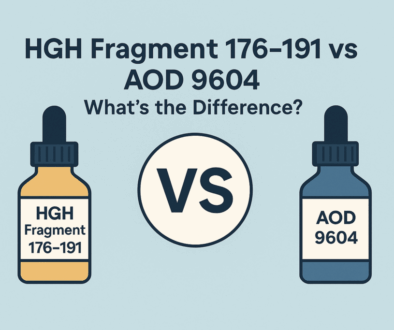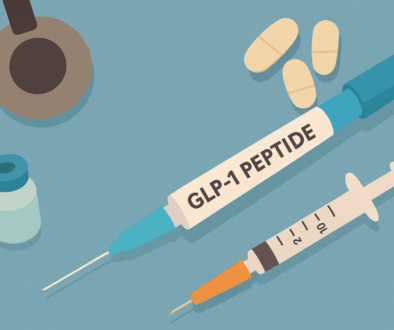What is ARA-290? A Complete Guide to This Breakthrough Healing Peptide

ARA-290 is a synthetic peptide made from erythropoietin (EPO), a hormone your body makes to produce red blood cells.
While EPO has powerful healing and anti-inflammatory effects, using it as medicine comes with a serious downside: it can create too many red blood cells, causing problems like blood clots and increased blood pressure.
Scientists solved this by creating ARA-290, a smaller piece of EPO that keeps all the healing benefits without affecting red blood cell production. ARA-290 is now gaining attention as a potential treatment for healing nerves & other injuries. Here’s everything you need to know about this exciting peptide.
Quick Summary:
- ARA-290 is a synthetic peptide that provides powerful healing and anti-inflammatory benefits without the dangerous side effects of regular EPO (like blood clots and high blood pressure).
- Clinical studies show ARA-290 effectively treats nerve pain in conditions like diabetes and sarcoidosis while actually repairing damaged nerves, not just masking symptoms.
- Research demonstrates excellent safety with minimal side effects, making ARA-290 a promising treatment for neuropathy, wound healing, and more.
Table Of Contents
ARA-290 Benefits
Research shows ARA-290 may have powerful benefits, including:
- Pain Relief and Nerve Repair: ARA-290 effectively reduces nerve pain in sarcoidosis and diabetes patients while actually repairing damaged nerves.
- Metabolic Health: In diabetics, ARA-290 improved blood sugar control (HbA1c) and cholesterol levels.
- Heart Protection: Studies show ARA-290 may protect the heart from damage during heart attacks, reduce inflammation, and preserve cardiovascular function during aging.
- Wound Healing: ARA-290 may accelerate wound healing and promote tissue repair across different types of injuries.
- Anti-inflammatory Effects: ARA-290 has potent anti-inflammatory effects that may be beneficial in a wide range of conditions.
- Safety Advantage: Unlike EPO, which causes dangerous side effects, ARA-290 provides powerful healing benefits with an excellent safety profile in clinical trials.
Did you know? EPO is perhaps most famously known for being abused by athletes like Lance Armstrong to illegally boost endurance performance by improving the blood’s oxygen-carrying capability.
Join Our Newsletter — Get 15% Off
Get the latest offers, peptide research insights, and stock updates.
How ARA-290 Works
ARA-290 works through your body’s natural emergency repair system called the innate repair receptor (IRR). When activated, the IRR helps reduce inflammation, prevent cell death, and encourage healing in damaged tissues like nerves, skin, and organs.
It’s considered a promising target for treatments that support recovery from injury, inflammation, or diseases involving tissue damage.
Different from Regular EPO
Regular EPO does two things: it makes red blood cells AND activates healing via the IRR. The red blood cell production can cause dangerous effects like blood clots and even a heart attack. ARA-290 was engineered to activate only the healing portion.
ARA-290 Research Evidence: What We Know So Far
ARA-290 has been examined in a growing number of human and animal studies, with the major focus being on healing neuropathy: damaged nerves. Here’s a quick look at the most interesting findings.
Human Studies
One 2012 study looked at the benefits of ARA-290 in 22 people with sarcoidosis, a disease where the immune system causes clusters of inflammatory cells to form in organs like the lungs or skin. They were given ARA-290 (2mg) or placebo three times weekly for 4 weeks. Compared to placebo, the ARA 290 group showed significant symptom improvement, including reduced pain and improved quality of life, with no safety issues.
Meanwhile, a 2013 study measured actual nerve fiber density in sarcoidosis patients receiving ARA-290. ARA-290 increased corneal nerve fiber density, providing objective evidence that it actually helps regrow damaged nerves, not just reduce symptoms.
Furthermore, a 2014 study looked at diabetic patients self-injecting 4mg ARA-290 daily for 28 days. Subjects receiving ARA 290 improved in HbA1c and lipid profiles throughout the 56-day observation period. Neuropathic symptoms also improved significantly in the ARA 290 group.
Animal Studies
Aside from human studies, extensive animal studies have demonstrated ARA-290’s therapeutic potential across multiple conditions.
In a 2014 animal study, rats with nerve injuries were given different doses of ARA-290 over 10 days. ARA-290 provided dose-dependent, long-lasting pain relief (up to 20 weeks) by reducing inflammation in the spinal cord.
Meanwhile, in a 2009 rat study, ARA-290 and compounds similar to it significantly improved wound healing across several injury types by reducing inflammation, protecting blood vessels, and speeding up tissue repair.
Finally, in a 2023 study of rats, researchers found that long-term treatment with ARA-290 reduced heart inflammation, preserved heart function, and lessened age-related decline and frailty. The findings suggest ARA-290 may help support healthier aging by protecting heart tissue and reducing systemic inflammation.
Taken together, these studies highlight the impressive healing and anti-inflammatory potential of ARA-290.
Did you know? ARA-290, also known as Cibinetide during development, was previously studied as a potential treatment for depressive disorders.
Safety Profile
Unlike regular EPO, ARA-290 has shown excellent safety in clinical trials with very few side effects reported.
The most common side effects are mild and include minor injection site reactions like slight redness or discomfort. No potential safety issues were identified in diabetes studies, and no safety concerns were raised by clinical or laboratory assessments in sarcoidosis trials.
Overall, ARA-290’s safety profile is one of its biggest advantages, providing powerful healing benefits without the serious risks of EPO.
Who Might Benefit Most
ARA-290 shows particular promise for people with:
- Diabetic nerve pain and complications
- Sarcoidosis-related neuropathy
- Chronic inflammatory conditions
- Poor wound healing
- Those seeking tissue repair without EPO’s cardiovascular risks
- Overall nerve healing
Bottom Line
ARA-290 represents a significant breakthrough in peptide therapy, offering the tissue-protective benefits of EPO without the dangerous side effects.
It’s currently in Phase II clinical trials for multiple conditions, including diabetic neuropathy, sarcoidosis-related nerve pain, and metabolic disorders.
Future research will likely explore its potential in wound healing, cardiovascular protection, and anti-aging applications.
Having said that, ARA-290 remains experimental; more research is needed to fully understand its potential and optimal dosing protocols.
-
- Heij, Lara, et al. “Safety and efficacy of ARA 290 in sarcoidosis patients with symptoms of small fiber neuropathy: a randomized, double-blind pilot study.” Molecular medicine 18 (2012): 1430-1436.
- Dahan, Albert, et al. “ARA 290 improves symptoms in patients with sarcoidosis-associated small nerve fiber loss and increases corneal nerve fiber density.” Molecular medicine 19 (2013): 334-345.
- Brines, Michael, et al. “ARA 290, a nonerythropoietic peptide engineered from erythropoietin, improves metabolic control and neuropathic symptoms in patients with type 2 diabetes.” Molecular medicine 20 (2014): 658-666.
- Swartjes, Maarten, et al. “ARA 290, a peptide derived from the tertiary structure of erythropoietin, produces long-term relief of neuropathic pain coupled with suppression of the spinal microglia response.” Molecular pain 10 (2014): 1744-8069.
- Erbayraktar, Zübeyde, et al. “Nonerythropoietic tissue protective compounds are highly effective facilitators of wound healing.” Molecular medicine 15 (2009): 235-241.
- Winicki, Nolan M., et al. “A small erythropoietin derived non-hematopoietic peptide reduces cardiac inflammation, attenuates age associated declines in heart function and prolongs healthspan.” Frontiers in Cardiovascular Medicine 9 (2023): 1096887.



